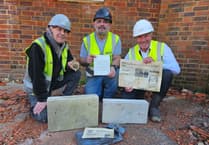"Shaky and lightly built by the profiteering contractor whose name they bear."
So said Winston Churchill about the home of every British Prime Minister since 1735 — Downing Street in London. A street whose name is synonymous with political power, scandal, and historical events, it has become far more than just an address; it is now a symbol of British politics itself.
The London version of Downing Street, undoubtedly more famous than Farnham’s own one, has seen it all. From Covid-era lockdown parties and disputes over luridly excessive gold wallpaper to terror attacks and the devastating bombings of World War II, it has been a constant stage for drama, political manoeuvering, and national crisis.
Its most famous address, Number 10, is now more than just the Prime Minister's residence; it has become shorthand for the office of the Prime Minister itself.
Downing Street in Farnham, however, may not be the scene of international political drama, but this quaint road has recently gained its own notoriety — not for any political significance, but for the gridlock caused by ongoing town centre refurbishments.
The London street was designed by Sir Christopher Wren, funded by the rapacious property developer Sir George Downing.
“It is unfortunate that he was such an unpleasant man. Able as a diplomat and a government administrator, he was miserly and at times brutal,” said a biographer of his.
Under Downing’s supervision, between 1682 and 1684, existing properties behind Horse Guards were torn down, and in their place, a cul-de-sac of 15 to 20 terraced houses was built along the north side of the new street — Downing Street.
Showing that developers cutting corners is not a modern phenomenon, the houses were cheaply constructed, with poor foundations for the boggy ground. Instead of neat brick façades, they had mortar lines drawn on to give the appearance of evenly spaced bricks.
By the time Benjamin Disraeli became Prime Minister, the house was in poor shape. The living quarters had not been used for 30 years, and Disraeli described it as “dingy and decaying.” It was time for modernisation.
The late 19th and early 20th centuries saw Number 10 Downing Street transformed from a humble terraced house into a grand residence with modern facilities — a home and office fit for the most powerful politician in the country.
Today, it’s either a “soulless cage — with fleas,” as Liz Truss described it during her brief tenure, or “a gorgeous family home,” as portrayed by Rishi Sunak’s wife, Akshata Murty, during her slightly longer stay.
The Farnham street is a far cry from its London counterpart. Unlike the bustling political heart of London, Farnham’s Downing Street used to be a relatively quiet residential and shopping centre, lined with traditional Georgian homes and charming buildings.
While the road was already established by the early 16th century, the origins of its name remain somewhat unclear. The most likely explanation is that it was once known as ‘Downlinking Street,’ a route used by monks traipsing into town from Waverley Abbey.
Jonathan Wood’s excellent book A Portrait of Farnham offers further insight into the area’s history, including the fact that it housed a petrol station from 1928 until 1955 — an ideal stop for cars running low on fuel while stuck in today’s long queues.
Number 3 Downing Street, built in 1717, was also “probably the earliest significant Farnham property to feature a parapet as part of its original design.” If this doesn’t bring it a touch of fame, nothing will.
Yet both streets share something in common: they have played important roles in the histories of their respective locales.
In the end, both streets, though vastly different in scope and significance, reflect the passage of time and the changing nature of their environments — one through the lens of national politics and the other through the experience of local life.





Comments
This article has no comments yet. Be the first to leave a comment.